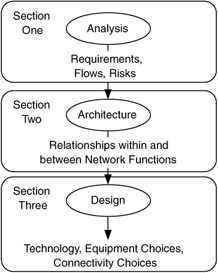1.3 Background
1.3 Background
Network analysis, architecture, and design have traditionally been considered art, combining an individual's particular rules on evaluating and choosing network technologies; knowledge about how technologies, services, and protocols can be meaningfully combined; experience in what works and what doesn't; along with (often arbitrary) selections of network architectures. However, as in other types of art, success of a particular network architecture or design often depends primarily on who is doing the work, with results that are rarely reproducible. This may have been acceptable in the early days of networking, when networks were more of a hobby than a critical resource and did not support revenue generation. Today, however, networks are embedded within our work and home lives. They are considered "mission-critical" to corporate success and provide near real-time access to information throughout the world. As such, a network's architecture and design must be logical, reproducible, and defensible. This premise is the foundation for this book.
Traditionally, network analysis, architecture, and design have been based on developing and applying a set of rules for the network. In developing a set of rules, an individual may draw from experience or from general rules such as the 80/20 rule (where 80% of a network's traffic is local, and 20% is remote) or the adage "bridge when you can, route when you must" (bridging being simpler, easier, and cheaper at the time). Both of these rules have been modified, as we will see later in the book. Such rules were useful when there weren't many choices in network technologies, services, and interconnection strategies and when the differences between choices were clearly understood. But times have changed, and our notion of architecting and designing networks must adapt to the variety of options now available to us, the many different types of services we can offer to our end customers (users), and the subtleties between technologies.
Network analysis, architecture, and design have traditionally focused on capacity planning, which is estimating capacity (also known as bandwidth) required in the network to accommodate most short-and long-term traffic fluctuations. As network traffic grows, this bandwidth "buffer" provided by capacity planning reduces and customers experience problems related to congestion. Some common solutions are to "throw bandwidth at the problem," increasing the bandwidth buffer to (hopefully) reduce congestion, or to overengineer the network, intentionally adding capacity to accommodate network fluctuations. This approach often does not work, as network bandwidth is only one component of network resources that must be considered. We now also need to consider how delay performance can be optimized. And, in many cases, network reliability, maintainability, and availability, also known as RMA (more on this in Section 1.9), are more important than overall throughput.
In this book we will explore how the analysis, architecture, and design processes have changed and how they continue to change. We will discuss how these processes work together in engineering a new or existing network. We will approach networks from a different perspective—as a system providing services to customers—and we discuss how networks can be architected and designed to provide many different types of services to its customers (users). In taking this approach, we will emphasize network analysis, which helps us understand what will be required of a network in supporting its customers and their applications and devices. As we will see, these processes require an investment of time and effort, but the return on investment is significant. They are powerful tools that can help you build better networks.
This book begins by applying a systems methodology to networking. This methodology is relatively new, and you will learn a number of useful definitions for network analysis, architecture, and design. The rest of the book is logically divided into three sections. The first section covers the analysis process, consisting of how to develop requirements, flow, and risk analyses. The analysis process prepares you for network architecture and design, discussed in the following two sections. The second section discusses how to understand the relationships between functions within your network and how to develop an architecture describing these relationships. In the final section the network architecture is used as input for the network design process, where technology selection and connectivity are determined. The information flows between network analysis, architecture, and design are presented in Figure 1.1.

Figure 1.1: Information flows between network analysis, architecture, and design.
Network analysis, architecture, and design will help you identify and apply the services and performance levels that your network must satisfy. Through these processes, you will be able to architect and design your network to provide the desired services and performance levels and will be able to choose the appropriate network technologies and interconnection strategies to meet your architectural and design goals.
EAN: 2147483647
Pages: 161
- Measuring and Managing E-Business Initiatives Through the Balanced Scorecard
- Technical Issues Related to IT Governance Tactics: Product Metrics, Measurements and Process Control
- Governing Information Technology Through COBIT
- Governance in IT Outsourcing Partnerships
- The Evolution of IT Governance at NB Power